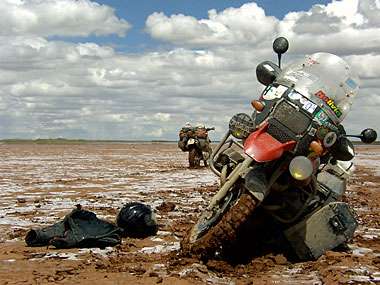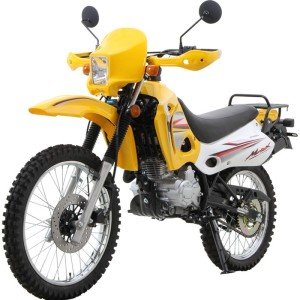 There are many facets to consider when choosing your first dual sport motorcycle – first and foremost being size. To do this begin with trying to determine what your expectations are. Do you want a street bike that can go in the dirt or a dirt bike that can go on the street? Something in between? When on the asphalt will you be cruising for long distances at highway speeds? When off road will you be on gravel roads, dirt roads, rough two track, or technical single track? In order for a motorcycle to be able to navigate a variety of conditions, there will always be compromises.
THE TRACTOR, THE TANK, & THE SCHOOL BUS
These are just a few affectionate monikers I’ve heard riders call their large displacement motorcycles. A good general rule of thumb is the longer the distances and higher the speeds, the higher the displacement should be. From 1200cc down to the 650’s, these adventure bikes are going to tolerate long journeys at highway speeds the best. No straining engines or inability to shake the occasional tail gater, just grab some more throttle and you’re gone. These machines also tend to be more ergonomically friendly as well. Wide seats with thick foam and plush suspension can make all day rides less arduous and less likely to end with you buying a tube of Preparation H. As with most metric bikes, these motorcycles tend to be well balanced, given their sizable girth and formidable weight. And in that weight lies the compromise.
I spotted a magazine ad recently that made me laugh out loud. It pictured a lone adventure rider in his early 60s straddling a battle dressed BMW R1200GS loaded with every option conceivable, including panniers. The scene had him stopped atop a rocky outcropping gazing reflectively off in the distance. It was a really cool picture of a cool guy on a very cool looking bike. Cool factor aside, I found it’s implications a bit ridiculous. If this guy is riding alone in the middle of nowhere and ever crashed or even tipped over, there’s no way in hell he’s picking that bike up. He better hope the local high school wrestling team wanders by. If he’s ever trapped under the motorcycle, I certainly hope he has a cell phone within reach and is in a service area, else he’ll be gnawing his leg off to get out from under it. That’s the crux of these bikes. Very comfortable with plenty of power but when the road gets rough are you throwing the bike around or is the bike throwing you around?
There are many facets to consider when choosing your first dual sport motorcycle – first and foremost being size. To do this begin with trying to determine what your expectations are. Do you want a street bike that can go in the dirt or a dirt bike that can go on the street? Something in between? When on the asphalt will you be cruising for long distances at highway speeds? When off road will you be on gravel roads, dirt roads, rough two track, or technical single track? In order for a motorcycle to be able to navigate a variety of conditions, there will always be compromises.
THE TRACTOR, THE TANK, & THE SCHOOL BUS
These are just a few affectionate monikers I’ve heard riders call their large displacement motorcycles. A good general rule of thumb is the longer the distances and higher the speeds, the higher the displacement should be. From 1200cc down to the 650’s, these adventure bikes are going to tolerate long journeys at highway speeds the best. No straining engines or inability to shake the occasional tail gater, just grab some more throttle and you’re gone. These machines also tend to be more ergonomically friendly as well. Wide seats with thick foam and plush suspension can make all day rides less arduous and less likely to end with you buying a tube of Preparation H. As with most metric bikes, these motorcycles tend to be well balanced, given their sizable girth and formidable weight. And in that weight lies the compromise.
I spotted a magazine ad recently that made me laugh out loud. It pictured a lone adventure rider in his early 60s straddling a battle dressed BMW R1200GS loaded with every option conceivable, including panniers. The scene had him stopped atop a rocky outcropping gazing reflectively off in the distance. It was a really cool picture of a cool guy on a very cool looking bike. Cool factor aside, I found it’s implications a bit ridiculous. If this guy is riding alone in the middle of nowhere and ever crashed or even tipped over, there’s no way in hell he’s picking that bike up. He better hope the local high school wrestling team wanders by. If he’s ever trapped under the motorcycle, I certainly hope he has a cell phone within reach and is in a service area, else he’ll be gnawing his leg off to get out from under it. That’s the crux of these bikes. Very comfortable with plenty of power but when the road gets rough are you throwing the bike around or is the bike throwing you around? SOMEWHERE IN BETWEEN
From 650cc’s down to 350cc’s you’ll find somewhat of a happy medium. These bikes tend to be more user friendly in the rough stuff and you can actually pick them up off the ground without having the physique of a carnival strongman or disassembling them halfway. This also affords the rider a greater possibility of actually enjoying being in more technical terrain rather than merely surviving it. Back on the road these motorcycles can cruise at highway speeds all day long. The question becomes – can you?
Ergonomically speaking these bikes are more like a bar stool than a recliner. Yes you can sit on one all day, but without the benefit of alcohol, do you want to? My DRZ400 has a seat slightly wider than a two by four. Even though it’s made of foam rather than wood, I don’t know if I really want to spend over 300 miles on it. And while it will reach over 80mph on the open road, it becomes miserable when fighting a crosswind. For me this is an acceptable tradeoff, as I only want to be on the asphalt long enough to get me to the dirt.
THE FEATHER WEIGHTS
Below 300cc’s is some what of a no man’s land. As in no man wants to be seen riding what his friends jokingly refer to as ‘the wife’s bike’. Make no mistake, these motorcycles may have small displacements but they can be big fun, particularly when it comes to being off road. Light and nimble, they manuever easily in tight terrain and are perfect for single track or beginner and scoot around town bikes. Where they become sorely lacking is on the open road. I’ll call this the ‘hey guys wait for me’ factor. Riding up a long steep grade feels like watching paint dry. Add a head wind and its like watching your toe nails grow. Make sure to bring along a book.
Another problem with a smaller cc motorcycle is that riders tend to out grow them quickly. This can be frustrating after spending thousands of dollars on a bike, only to be left wanting more in a short period of time.
OTHER CONSIDERATIONS
Most bikes can be fine tuned to better suit an individuals wants and needs, minimizing compromises. There is a vast array of aftermarket parts and add-ons for dual sport motorcycles. Companies like Touratech and Western Power Sports have huge catalogues that rival the Manhattan phone book in size. Seat upgrades, handlebar risers, and heated grips can help improve ergonomics and rider comfort. Large aftermarket tanks can increase a bike’s range; high performance engine mods can increase horsepower. Changing the bikes gearing (sprocket sizes) can provide more low-end torque or achieve higher top speeds. Although this example creates more compromise; increase one and you inevitably decrease the other.
Something else to consider is resale value. If this is your first motorcycle (buy used!) it probably won’t be your last. Spending a bit more for quality and a proven brand helps ensure a higher resale value and a quicker sale.
SUMMIN UP
No one knows you better than, uh, you. Unless you have a therapist. Before any impulsive purchases think hard about what you know you want now and what you think you might want in the future. When I bought my first street bike I was sure I’d never want to ride off road. Then I rode a friends dirt bike. Make sure to do the homework – research power to weight ratios and read reviews. See what aftermarket parts are available. Track down the bike(s) you’ve decided on and actually sit on them. Feel the ergonomics and the way they’re balanced. Imagine having to push them out of sand or dig them out of the mud. Figure out how difficult it would be to repair a flat in the middle of nowhere. Take the bike for a ride and stand on the foot pegs; twist the throttle. Remember that no matter what you end up with, there’s bound to be some compromise.
SOMEWHERE IN BETWEEN
From 650cc’s down to 350cc’s you’ll find somewhat of a happy medium. These bikes tend to be more user friendly in the rough stuff and you can actually pick them up off the ground without having the physique of a carnival strongman or disassembling them halfway. This also affords the rider a greater possibility of actually enjoying being in more technical terrain rather than merely surviving it. Back on the road these motorcycles can cruise at highway speeds all day long. The question becomes – can you?
Ergonomically speaking these bikes are more like a bar stool than a recliner. Yes you can sit on one all day, but without the benefit of alcohol, do you want to? My DRZ400 has a seat slightly wider than a two by four. Even though it’s made of foam rather than wood, I don’t know if I really want to spend over 300 miles on it. And while it will reach over 80mph on the open road, it becomes miserable when fighting a crosswind. For me this is an acceptable tradeoff, as I only want to be on the asphalt long enough to get me to the dirt.
THE FEATHER WEIGHTS
Below 300cc’s is some what of a no man’s land. As in no man wants to be seen riding what his friends jokingly refer to as ‘the wife’s bike’. Make no mistake, these motorcycles may have small displacements but they can be big fun, particularly when it comes to being off road. Light and nimble, they manuever easily in tight terrain and are perfect for single track or beginner and scoot around town bikes. Where they become sorely lacking is on the open road. I’ll call this the ‘hey guys wait for me’ factor. Riding up a long steep grade feels like watching paint dry. Add a head wind and its like watching your toe nails grow. Make sure to bring along a book.
Another problem with a smaller cc motorcycle is that riders tend to out grow them quickly. This can be frustrating after spending thousands of dollars on a bike, only to be left wanting more in a short period of time.
OTHER CONSIDERATIONS
Most bikes can be fine tuned to better suit an individuals wants and needs, minimizing compromises. There is a vast array of aftermarket parts and add-ons for dual sport motorcycles. Companies like Touratech and Western Power Sports have huge catalogues that rival the Manhattan phone book in size. Seat upgrades, handlebar risers, and heated grips can help improve ergonomics and rider comfort. Large aftermarket tanks can increase a bike’s range; high performance engine mods can increase horsepower. Changing the bikes gearing (sprocket sizes) can provide more low-end torque or achieve higher top speeds. Although this example creates more compromise; increase one and you inevitably decrease the other.
Something else to consider is resale value. If this is your first motorcycle (buy used!) it probably won’t be your last. Spending a bit more for quality and a proven brand helps ensure a higher resale value and a quicker sale.
SUMMIN UP
No one knows you better than, uh, you. Unless you have a therapist. Before any impulsive purchases think hard about what you know you want now and what you think you might want in the future. When I bought my first street bike I was sure I’d never want to ride off road. Then I rode a friends dirt bike. Make sure to do the homework – research power to weight ratios and read reviews. See what aftermarket parts are available. Track down the bike(s) you’ve decided on and actually sit on them. Feel the ergonomics and the way they’re balanced. Imagine having to push them out of sand or dig them out of the mud. Figure out how difficult it would be to repair a flat in the middle of nowhere. Take the bike for a ride and stand on the foot pegs; twist the throttle. Remember that no matter what you end up with, there’s bound to be some compromise.





